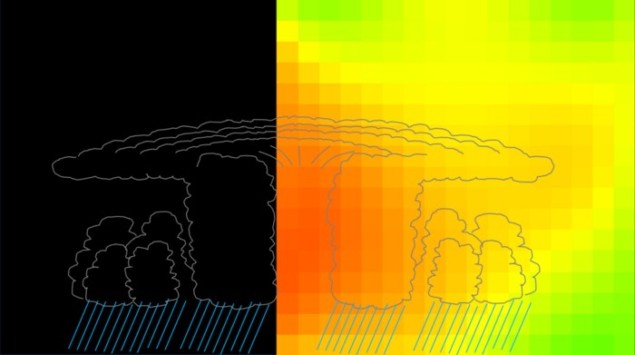Cosmic muons probe the interiors of tropical cyclones
18 Oct 2022
Peering inside: the image on the right shows the interior of a cyclone. The redder areas are regions of lower pressure, and the greener areas are higher pressure. (Courtesy: Hiroyuki KM Tanaka)
Cosmic muons have been used to image structures deep within tropical storms, according to an international team of researchers. Led by Hiroyuki Tanaka at the University of Tokyo, the team used a network of muon detectors to identify differences in air density within several typhoons. Through further improvements, their approach could provide important information for early warning systems for severe storms.
Tropical cyclones such as typhoons and hurricanes cause a great deal of damage – and sometimes loss of life – across a wide swathe of the Earth’s lower latitudes. As a result, people rely on warning systems that can predict storm strengths and trajectories as accurately as possible. Today, forecasts rely heavily on satellite images. These can provide detailed aerial views of evolving air patterns but offer far less information about the 3D structures of air pressure and density contained within cyclones. These features are often crucial to predicting how a storm will develop in the future.
Tanaka’s team has shown that the rapidly-developing technique of muography can be used to study storms in 3D. Their approach uses the multitude of muons produced when cosmic rays collide with atoms in the upper atmosphere. Most of these muons will then travel to the surface of the Earth, where they can be detected.
Measuring attenuation
Muography takes advantage of the fact that some muons are absorbed as they travel to detectors on Earth – by the atmosphere, the sea and even by solid structures such as buildings. Physicists can calculate the rate at which cosmic muons are produced, so they know how many to expect on the ground – allowing then to determine how much attenuation occurs along the way.
Muography measures this attenuation and uses that information to create an image of the intervening structure. So far, the technique has been used to image the interior of an Egyptian pyramid and monitor water depth in Tokyo Bay.
Now, Tanaka and colleagues have used muography to study eight typhoons that struck the Japanese city of Kagoshima in 2016–2021. They focussed on the density of the air within the cyclones – with denser air absorbing more muons.
Vertical profiles
Using a network of scintillator detectors on the ground, the researchers built up vertical profiles of the air density within the storms, while capturing the time evolution of the density. The detectors clearly showed how warm, low-pressure cores in the typhoons were encircled by cold, high-pressure exteriors. These structures cannot be detected in satellite images alone.READ MORE

The team is making further improvements to its detector network, which will allow the detection of atmospheric muons from multiple directions. With this upgrade, Tanaka and colleagues hope that muography could be used to spot storms from as far away as 300 km, and forecast their future development in real time. If combined with satellite images and barometric data, this could ultimately lead to far more accurate early warning systems for tropical cyclones – providing communities with vital time to prepare for imminent natural disasters.
The research is described in Scientific Reports.
Sam Jarman is a science writer based in the UK.
from physicsworld.com 2/11/2022

Δεν υπάρχουν σχόλια:
Δημοσίευση σχολίου